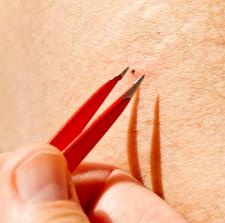

In recent years, the CDC estimated approximately 30,000 new cases of Lyme disease annually, making Lyme the most commonly reported tick-borne illness in the United States. But many cases go unreported, and CDC officials now admit that 30,000 cases is a gross underestimate.
“We know that routine surveillance only gives us part of the picture, and that the true number of illnesses is much greater,” said Paul Mead, M.D., M.P.H, chief of epidemiology and surveillance for CDC’s Lyme disease program in a press release. “This new preliminary estimate confirms that Lyme disease is a tremendous public health problem in the United States, and clearly highlights the urgent need for prevention.”
Should you be concerned about Lyme?
Today, ninety-six percent of Lyme disease case reports in the U.S. come from 13 states: Connecticut, Delaware, Maine, Maryland, Massachusetts, Minnesota, New Hampshire, New Jersey, New York, Pennsylvania, Vermont, Virginia and Wisconsin.
If you live in one of these states, understanding how to protect yourself is key. Deer ticks, the carriers of Lyme disease can be so small, they are nearly impossible to see. Often, they are no larger than the period at the end of this sentence. And many people with Lyme disease never see or feel a tick on their body.
The CDC encourages everyone to wear insect repellent and perform daily body checks for ticks after being outdoors. This will not only prevent against Lyme disease, but other tick-borne illnesses as well.
If you spot a tick or think you have been bitten
According to the CDC, if a tick is attached to your skin for less than 24 hours, your chance of getting Lyme disease is relatively small. Remove the tick using fine-tipped tweezers. Grasp it as close to the skin’s surface as possible, and pull upward with steady, even pressure, not allowing any part of the insect to break off or remain in the skin. Then, clean the bite with rubbing alcohol.
After a tick bites, some people experience a red, expanding rash around the site of the bite. Others have symptoms such as fatigue, fever, achy joints or swollen lymph nodes. If you experience any of these symptoms, it is important to see your physician right away, as these are indicators of Lyme disease.
Lyme disease diagnosis and treatment
Diagnosing Lyme disease is tough. It takes a tick at least 36 hours for a tick to transmit the bacteria to your body but it can take weeks for a blood test to detect any Lyme antibodies. Even then, some who are infected will test negative in error. And some without the illness will test positive.
If you are diagnosed early, Lyme disease can easily be treated with a course of antibiotics. If left untreated, the bacteria can spread to the heart, joints, muscles—even the brain. But the real question is: why do so many patients remain sick even after they have received treatment?
A great deal of controversy and debate surrounds the treatment of patients with “chronic Lyme.” Some doctors, and many patients believe that the bacteria can hide in the body for years and resist antibiotic therapy. Additionally, many of these patients suffer from co-infections, such as babesia or bartonella, which are also transmitted by the tick. These co-infections often require a separate set of treatments.
If you like this post, please read other posts in the series on the Person-Centered HealthCare main page. And if you have a story to tell that may be a fit with our series, please comment below or email me at joan@socialmediatoday.com